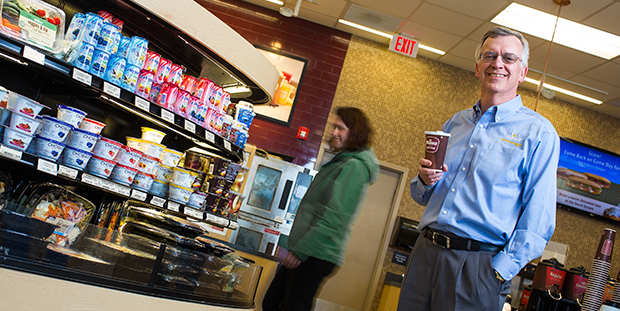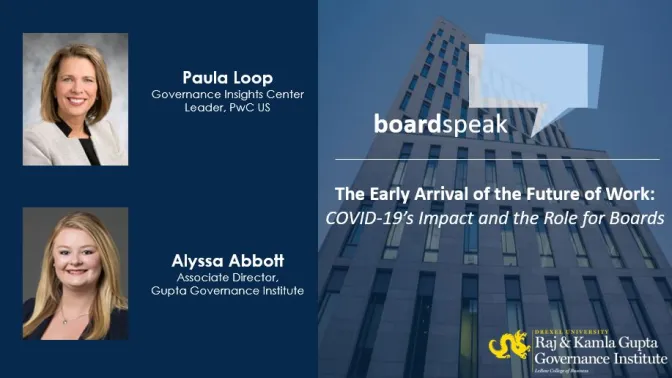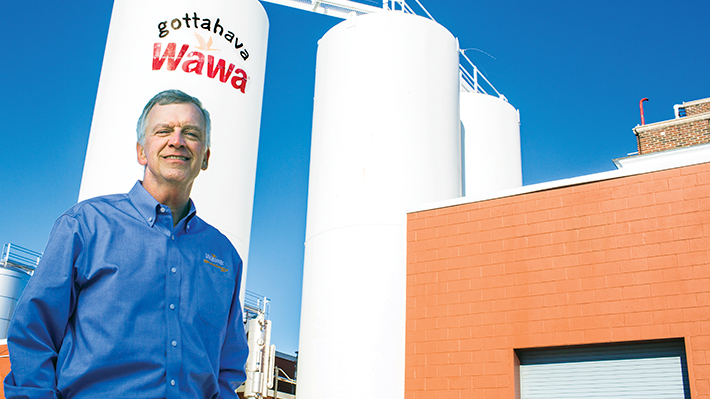
New Habitats for Wawa
Alumnus Leads Company’s Expansion Both Near and Far
It was early 2005, and Wawa — a convenience store whose namesake is a Native American word for goose — was getting ready to embark on an unprecedented migration. To be sure, the privately owned chain already dominated the Philadelphia-area’s convenience store landscape and saw its presence in states like Maryland and Virginia expand by small, but notable, degrees. Nonetheless the time had come to expand further than it ever had before, and it was Peter Gilligan’s job to find out where the goose would eventually land.
Gilligan (MBA ‘06) was a 20-year Wawa veteran and director of site acquisition at the time, which meant he was responsible for finding new Wawa locations, overseeing real estate negotiations, land acquisitions and leasing, and managing the land development and approval process that comes with building new stores. So when it came time to figure out Wawa’s next big move, it made sense that Gilligan would be appointed director of something called the “New Market Team.”
And so Gilligan and his team spent several years poring over mountains of data from dozens of potential metro areas throughout the country, all of it seeking to answer a long list of demographic questions like: How many people live or work within a four-minute drive of a certain street corner? How many people go to school nearby? How old is the median population? What’s the average income? Is there a big retail or employment center nearby? Where’s the competition?
In addition to the number crunching, Gilligan and his team traveled to dozens of U.S. cities, including Seattle, Miami, Boston, Maine and San Diego. Nothing was off the table when it came to finding a new home for Wawa.
“We looked everywhere, because we were really prepared to go anywhere in the country if it was the right place,” recalls Gilligan from an office inside Wawa’s Media, Pa., headquarters on a cold February afternoon. “This was a huge endeavor, because we didn’t want to just open a store here and there. We wanted to open a bunch of new stores. This was about long-term growth in uncharted territory.” Sometime during this frenzy, Gilligan and a few real estate experts from his New Market Team made a trip to Orlando, Fla., and it was there that something clicked.
If you’ve got a Wawa just up the street … Gilligan was probably responsible for bringing it there.
“There’s a balance that we talk about all the time between the art and the science of choosing a new location, and that’s what makes this interesting,” says Gilligan. “When I drove around Orlando, I knew we had some good numbers. But I also just got this feeling and kept thinking, ‘Ya know, this could be a great place for a Wawa.’ There was just … something there. A vibrancy. You could feel it.”
But that was just the beginning. The new market launch would wind up consuming nearly seven years of Gilligan’s professional life until, on July 18, 2012, Wawa opened its first Florida store in Orlando — exactly 973 miles from where the celebrated convenience store chain launched in Folsom, Pa., on April 16, 1964.
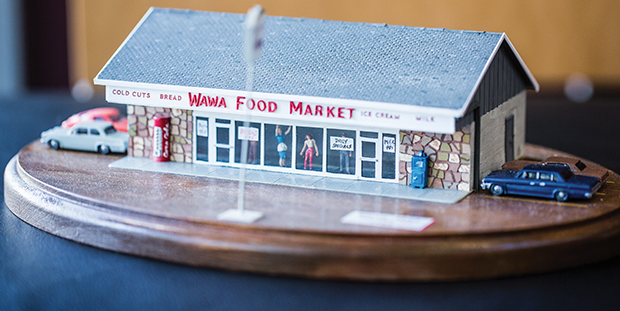
Model of the first Wawa in Folsom, PA, built in 1964
It’s been almost a decade now since Gilligan “got this feeling” about Orlando, and there are now 60 stores positioned throughout the central band of the Sunshine State, with 25 more to come in 2015. And while Gilligan is confident that Wawa’s success over the past several decades is predicated on slow, meaningful growth, he also doesn’t see any reason why the company can’t expand as far and as wide as it would like.
“I think one of the things our success in Florida has taught us is that we can probably go anywhere we want,” says Gilligan. “Ever since we saw that first Orlando store overrun with people, I’ve thought, ‘If we can take this brand 1,000 miles south, we can go to Texas, Chicago, California, St. Louis, you name it.’ We’ve got something special here.”
“People almost always said the same thing. ‘Just don’t screw up my Wawa,’” recalls Gilligan.
Location, location, location. The resounding axiom of real estate consideration might also serve as an apt tagline for Gilligan’s responsibilities at Wawa, where he currently serves as vice president and chief real estate officer for the storied chain. Basically, if you’ve got a Wawa just up the street from your home or office, Gilligan was probably responsible for bringing it there.
Gilligan is an intricate and essential part of the Wawa expansion machinery, spending most of his days traveling throughout the region to examine potential sites for future stores, always carefully considering that balance between the “art” and the science of site selection. For instance, he’s been spending a lot of time in northern New Jersey these days, wondering just how smoothly one of Philadelphia’s most treasured brands might take hold in the land of the Yankees, Mets, Giants and Jets.
“We’re very thin in North Jersey right now, so we’re investing a lot of money and time up there,” says Gilligan, 59. “It’s another big move, and there’s a lot to consider. North Jersey is filled with a lot of older delis and sandwich places. How will they accept something like us? It’s a risk, but it’s always exciting — if it’s done right.”
Real estate and development wasn’t always Gilligan’s cup of joe. Turn back the clock just a little bit and one finds Gilligan at home in Allentown, Pa., nurturing a childhood fascination with intricately designed bridges and buildings that would eventually lead him to study civil and urban engineering at the University of Pennsylvania. After graduating in 1978, he bounced around as a structural and project engineer for various Pennsylvania companies before landing a job at Wawa in 1985. At the time, the company was about to embark on one of its epochal expansions, and Gilligan got a feeling that they could use his engineering expertise.
“There was no real engineering role here, and I thought I could create one. But I thought I’d probably work here for a few years and then go get a ‘real job,’” Gilligan recalls with a laugh. “There’s no way I could have ever imagined that I’d build a career here.”
After 10 years at the company, Gilligan was promoted to director of engineering and construction which put him in charge of overseeing the architecture, design, construction and engineering for all new and remodeled Wawa stores. What’s more, he and his design team were responsible for the development of something brand new to the company at the time — its first gasoline superstore.
“We were about to make a leap and double the size of our stores, which meant a little change in the image and brand,” recalls Gilligan. “That was a very exciting time because it was a big, big change for us. And now 420 of our 680 stores have gas. It’s become a big part of our brand and what we offer.”
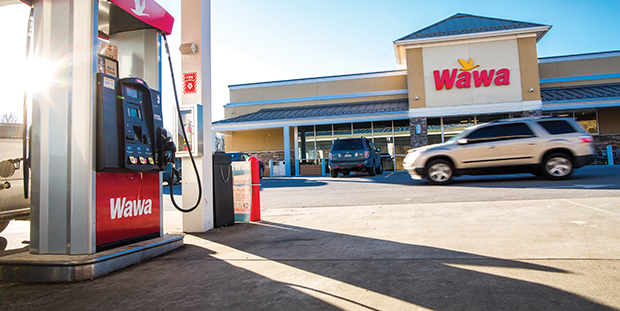
And much of Gilligan’s influences during that time period can still be seen today, like in the openness of the larger stores’ floor plans, the positioning of the coffee bar in relation to the condiments island, and in those iconic, slanted canopies covering the gas pumps.
“I can tell you those canopies were a much more expensive way to go, but we wanted to be different because we felt we were different,” says Gilligan. “We’re not just a gas station. We’re Wawa.”
That distinction — the one that suggests Wawa does, indeed, exude a particular retail ethos that separates it from the rest of the convenience store world — is one that’s shared both inside the company’s corporate halls as well as on the streets of Philadelphia, South Jersey, Delaware, Maryland, Virginia and Florida. There’s a devotion to Wawa not unlike fanaticism for a professional football team or dedication to specific family traditions.
“I came here first and foremost because I was impressed with the people. That’s also a large reason why I stayed.”
For instance, Gilligan recalls sitting in on many consumer focus groups leading up to the great gas station evolution of 1996. When the participants were asked what they thought about Wawa potentially getting into the retail petroleum business, the response was so frequent as to be practically unanimous.“People almost always said the same thing. ‘Just don’t screw up my Wawa,’” recalls Gilligan. “People put a lot of trust in us, that the things we do, we do well, and we’ve delivered on that with each new step we take. And that’s the imperative whenever we move forward.”
While we’re on the subject of distinction, it’s probably important to take a moment to point out some of Wawa’s more unique attributes as an organization, because it bears mentioning.
First of all, there’s this thing about “the people.” Do a Google news search for articles about Wawa and you’re bound to find no fewer than a dozen quotes from myriad employees up and down the hierarchy extolling the virtues of working with “the people” that make up the organization. And Gilligan is no exception.
When asked if there was a particular moment he knew he wanted to carve out a long-term career at Wawa, Gilligan says, “I came here first and foremost because I was impressed with the people. That’s also a large reason why I stayed.”
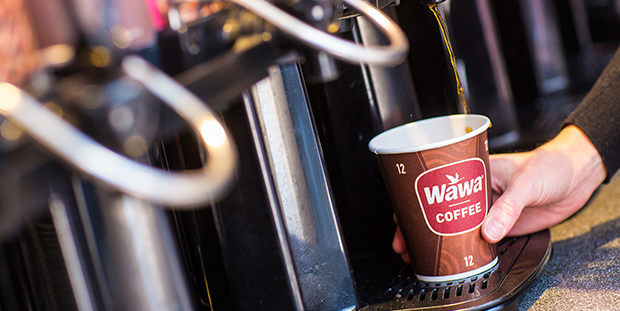
The cynic, of course, might just chalk this up to run-of-the-mill corporate speak — but there are some numbers to back up the claims. For instance, consider this passage from a 2014 Philadelphia Inquirer article celebrating Wawa’s 50th anniversary: “A Harvard Business Review study credited the company’s culture for Wawa’s relatively low employee turnover rate (22 percent vs. a triple-digit retail-sector average) and its financial performance (twice the growth rate of the S&P 500 from 1977 to 2003).”
And then there’s the employee stock ownership plan, otherwise known as ESOP.
According to Gilligan, Wawa employees are offered the option to buy company stock, which serves as a retirement plan that can work in conjunction with the company’s 401(k). Gilligan says roughly 42 percent of the private company is employee owned, a veritable manifestation of the organization putting its money where its mouth is. “Even part-time associates who work over 1,000 hours a year and are age 21 are eligible,” Gilligan says. “We have over 10,000 associates in our ESOP who are owners of Wawa.”
But the ESOP isn’t just about corporate feel-good-ness. There’s a larger strategy of success at play here. When employees own stock, they are probably going to take better care of the company for which they work.
“Wawa employees often feel strongly that their success is closely tied to that of the company, in large part because employee stock ownership makes it their company too,” wrote Kevin Post in a 2013 Press of Atlantic City article about Wawa’s unique corporate culture.
The ESOP has also allowed Wawa to remain a privately owned company. Prior to the 2012 passage of the Jumpstart Our Business Startup Act (JOBS), privately held businesses with $10 million in assets had to become publicly owned and traded after they amassed more than 500 shareholders. The JOBS Act, however, increased the shareholder minimum to 2,000 and also exempted employee shareholders from being counted toward that maximum.
“Private ownership has a number of concrete benefits for Wawa,” wrote former Wawa CEO Howard Stoeckel in his book, The Wawa Way: How a Funny Name & Six Core Values Revolutionized Convenience. He explained, “We don’t have quarterly reports that must be submitted to Wall Street…[and] we’re not making decisions, as a lot of companies do, based on what Wall Street analysts or minority investors think. We’re making decisions based on the best long-term interest of the business. Once a company goes public, it has no immunity to the whims of the markets and market investors … that can be intensely painful for organizations of all sizes.”
Talking about this focus on employee investment in the company brings Gilligan back to a specific moment in his history with this organization — the one where he realized Wawa would play a bigger part in his future than he initially thought.
Gilligan had been working for the company for about three years when he was invited to a Presidents Club retreat in the Poconos, a weekend-long excursion offered to the year’s top performers. Driving home from the event, Gilligan’s late wife, Mary Ellen, who earned an MS in Systems Engineering from Drexel in 1987, couldn’t stop raving about the experience they had shared.
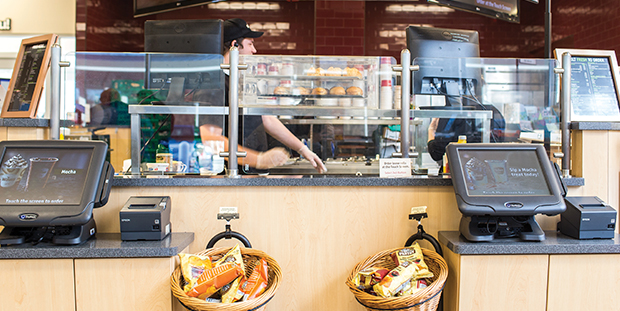
Thirty years of charting Wawa’s real estate and development course hasn’t come without a few missteps, as Gilligan is quick to point out.
“The science of site selection is never going to be 100 percent. Sure, we’ve got proprietary models that predict how many gallons of gas we’ll sell or how many hoagies we’ll make in a month, but none of these models are perfect,” says Gilligan, who earned his MBA from LeBow in 2006 at the age of 50. “That’s where the art complements the science. That’s what makes it interesting. But that’s also what makes it uncertain.”
For instance, when Wawa first expanded to Virginia in 1998, the stores were struggling. But that didn’t really make sense. The numbers were solid. The stores should have been booming. There was, however, an issue of perception that Gilligan and Co. hadn’t properly anticipated.
“In Virginia, we were seen mostly as a big gas station, and it was hard to convince people to come in and get food there because they weren’t used to popping into a gas station for a good sandwich,” says Gilligan. “We didn’t see that coming.”
But of course, Gilligan adds, these setbacks always serve as lessons moving forward. For instance, when Wawa set out on its Florida migration, the company decided to heavily advertise its food and coffee, letting the gas more or less sell itself. What’s more, Gilligan says many lessons have already been learned in Florida that will inform decisions the company makes as it looks to add 25 additional stores this year in the Northeast.
For instance, when customers walk into the Florida stores the first thing they see is an enormous made-to-order food station and bakery shelves. “The food is front and center,” says Gilligan. “That’s going to be a big thing moving forward.” There’s also a lot more glass, more “openness” to the floor plan, and even outdoor seating, which Gilligan says will soon begin cropping up in new and remodeled Northeast locations.
Also on the horizon, Gilligan will help lead what he calls “a vast remodeling and reinvestment plan” that will include a $500 million investment in the construction and renovation of 500 stores over the next five years.
“It’s a major investment of money and people into some older, tired looking Wawa stores that we’re going to help transform into beautiful Wawa stores,” says Gilligan.
Looking back, Gilligan thinks about his childhood passion for architecture. The way he used to marvel at those bridges and buildings. The passion he had to eventually build something himself. But what he’s helped build at Wawa, he says, is much more interesting and rewarding than the sum total of nuts and bolts.
“Yes, it started as building and putting things together. And yes, there’s a lot of pride when I drive past a store on Route 70 or 38 and think about how long it took to build. But when I sit back and look at what we’ve put together here, it’s much broader than just buildings. It’s the people,” says Gilligan. “It’s not just sitting down with calculators and maps and data. It’s about building these places with people and for people. That’s what gives me a tremendous sense of accomplishment.”
